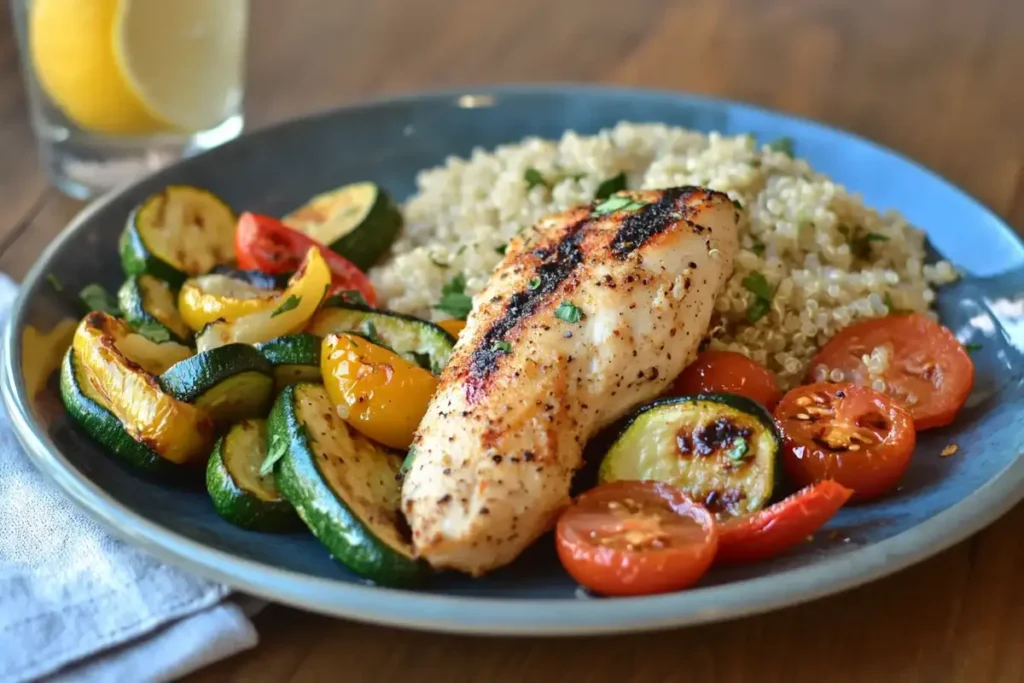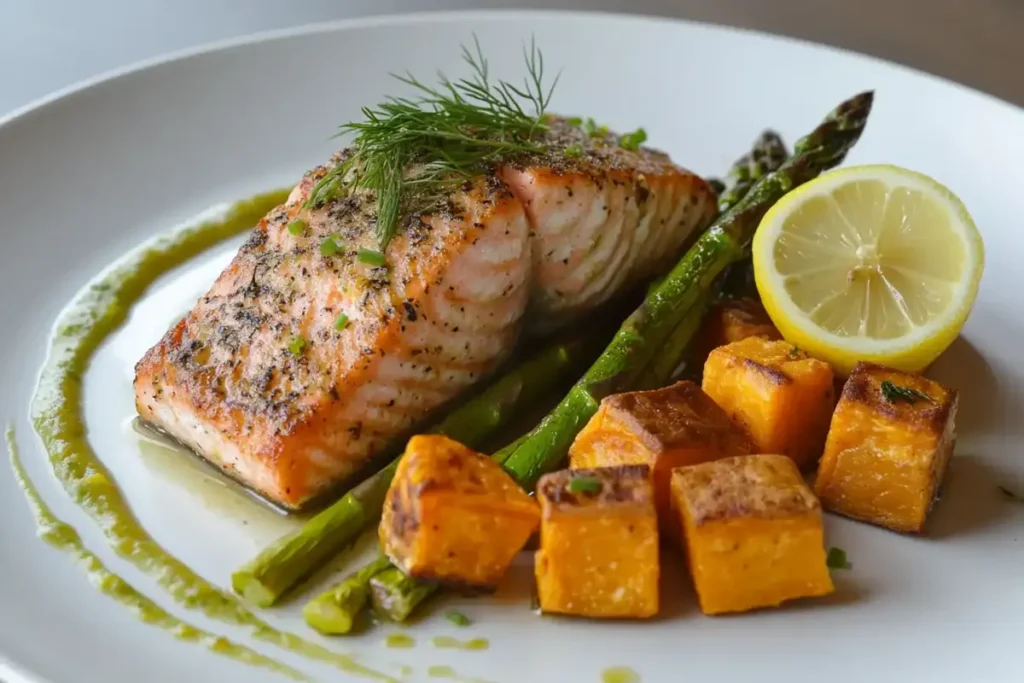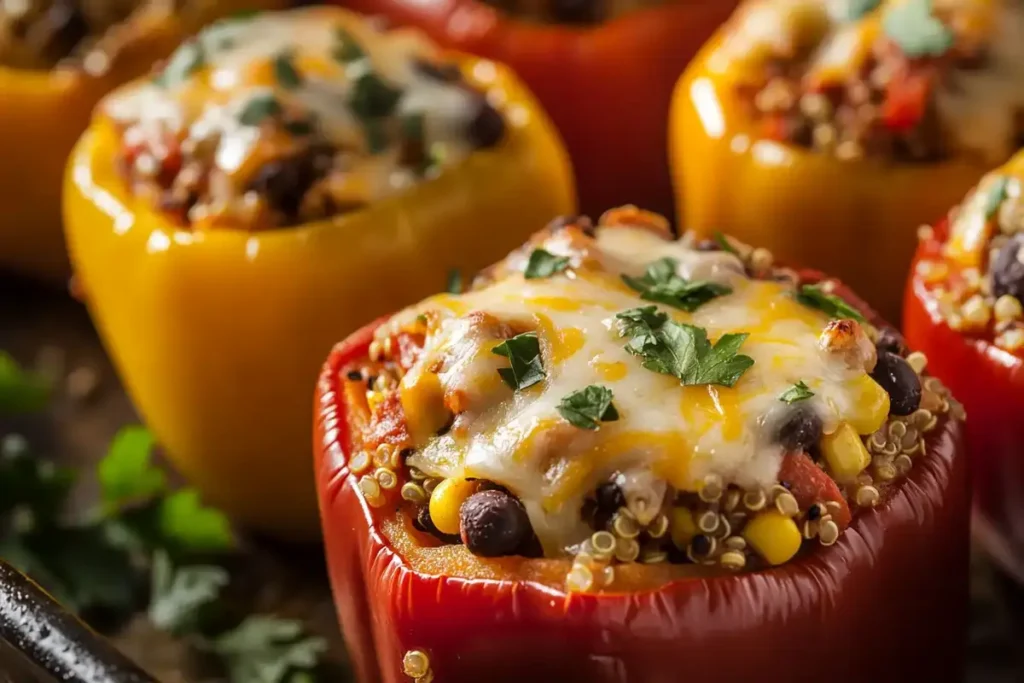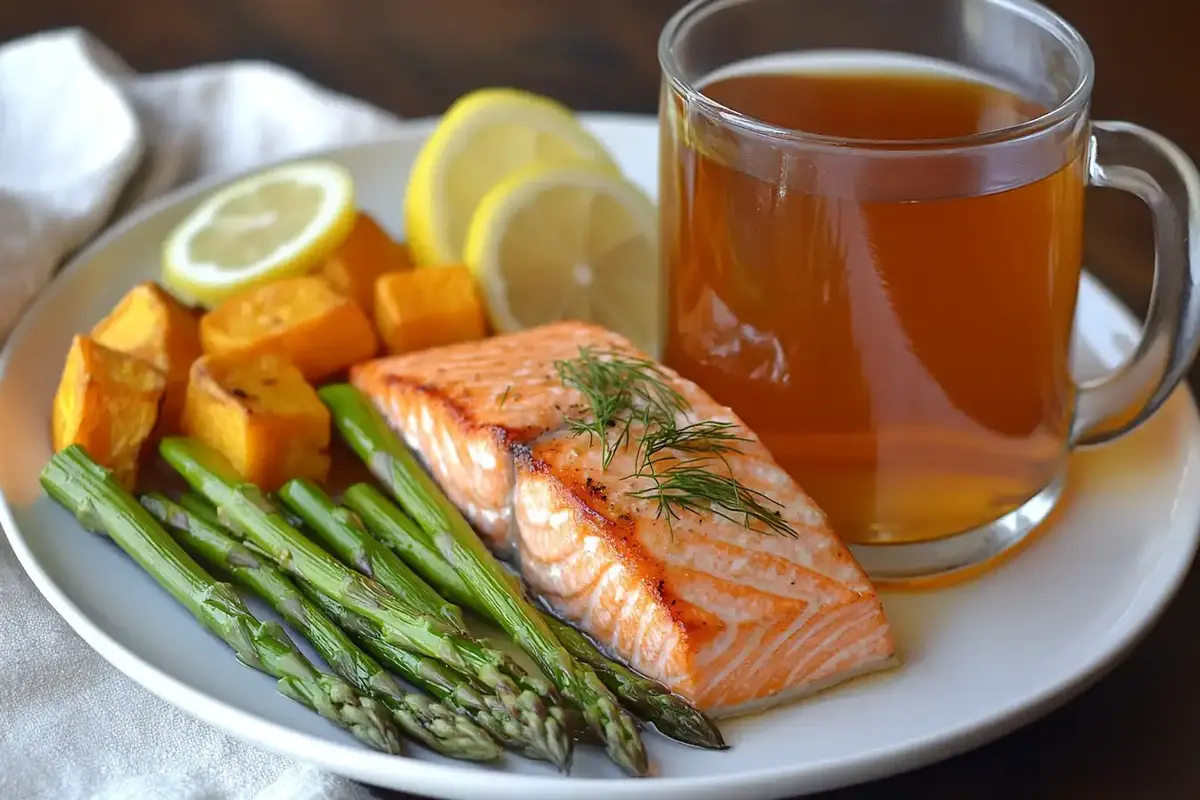Looking for high protein dinner recipes to fuel your day, boost energy, or achieve fitness goals? You’re in the right place! This guide will dive deep into mouthwatering recipes, the benefits of protein-packed meals, and tips to make your dinners both nutritious and exciting. Whether you’re a seasoned chef or just starting in the kitchen, these ideas are tailored to suit every taste and dietary preference.
Table of Contents
Introduction & Benefits of High Protein Dinners
Introduction
When it comes to healthy eating, high-protein dinner recipes steal the spotlight. They’re not just about gym-goers or athletes; they’re for anyone seeking balanced nutrition. Proteins are the building blocks of our bodies, making them essential for muscle repair, energy, and overall well-being. But here’s the catch how do you incorporate enough protein into your dinners without falling into the trap of repetitive meals? That’s what this article will cover, along with plenty of tips and creative ideas.
Benefits of High-Protein Dinners
Supports Muscle Growth and Repair
Protein is the powerhouse macronutrient that helps rebuild muscle tissues after wear and tear. Whether you’re recovering from a workout or just tackling a busy day, a protein-rich dinner provides the necessary fuel. For example, grilled chicken or lentils are fantastic options to load up your plate with these benefits.
Aids in Weight Loss
A high-protein meal keeps you full longer by reducing hunger hormones like ghrelin. Imagine savoring a flavorful black bean stuffed pepper that satisfies your taste buds and prevents late-night snacking it’s a win-win!
Boosts Metabolism and Energy
Proteins require more energy to digest compared to fats or carbs, which can slightly increase your metabolic rate. Pair that with nutrient-dense sides, like quinoa or roasted vegetables, for a balanced and energizing meal.
Promotes Overall Health
Beyond just muscles and metabolism, protein contributes to stronger hair, nails, and skin. Incorporating a mix of plant-based proteins and lean animal options ensures you’re covering all bases for long-term health.
Key Ingredients for High-Protein Dinner Recipes
When it comes to crafting high protein dinner recipes, choosing the right ingredients is essential. The beauty lies in the variety there’s a wealth of both animal-based and plant-based options that cater to diverse tastes and dietary needs. Let’s explore the stars of the protein world and how to pick the best ingredients for your meals.
Animal-Based Protein Sources
Lean Chicken, Turkey, and Pork
Lean meats are a staple in many high-protein diets. Chicken and turkey, particularly the breast portions, are low in fat but rich in protein. They’re also versatile—you can grill, bake, or sauté them to fit any recipe. Pork tenderloin is another lean option, though you might swap it out for alternatives if avoiding pork.
Fish and Seafood (Salmon, Tuna, Shrimp)
Seafood is not only high in protein but also packed with heart-healthy omega-3 fatty acids. Salmon is a standout for its nutrient density, while tuna offers a quick, lean option, perfect for salads or wraps. Shrimp, with its subtle flavor, complements stir-fries and pasta dishes beautifully.
Eggs and Dairy (Greek Yogurt, Cottage Cheese, Milk)
Eggs are often dubbed nature’s multivitamin thanks to their balance of protein and essential nutrients. Pairing them with high-protein dairy products like Greek yogurt or cottage cheese creates filling, delicious dinners. Don’t forget milk—it can double as a protein base for soups or creamy sauces.
Plant-Based Protein Sources
Legumes (Lentils, Chickpeas, Black Beans)
Legumes are a powerhouse of plant-based proteins. Lentils, for instance, provide about 18 grams of protein per cup and are excellent in soups, stews, or salads. Chickpeas, whether roasted or pureed into hummus, bring versatility to your table. Black beans, combined with rice or quinoa, create a perfect protein-rich combination.
Tofu, Tempeh, and Seitan
For vegans and vegetarians, tofu and tempeh are lifesavers. Tofu absorbs the flavors of marinades beautifully, while tempeh’s nutty texture works well in stir-fries. Seitan, made from wheat gluten, mimics the texture of meat and is a must-try for those seeking a hearty option.
Nuts, Seeds, and Nut Butters
Nuts and seeds like almonds, chia seeds, and sunflower seeds are compact sources of protein. Adding a tablespoon of peanut or almond butter to sauces or dressings can amplify both protein content and taste.
Combination Proteins
Quinoa: A Complete Plant Protein
Quinoa is a rare gem among plant-based options because it contains all nine essential amino acids, making it a complete protein. Serve it as a base for bowls, or mix it with vegetables for a wholesome side.
Pairing Beans with Rice or Whole Grains
When paired together, beans and grains complement each other to form a complete protein profile. For instance, combining lentils with brown rice not only elevates the nutritional value but also enhances texture and flavor.
Tips for Selecting High-Protein Ingredients
- Opt for Minimally Processed Items
Processed ingredients often contain additives or excess sodium. Always choose whole, natural forms of proteins whenever possible. - Check Protein Content per Serving on Labels
Not all proteins are created equal! Reading nutritional labels can help you prioritize options with higher protein-to-calorie ratios.
Top High-Protein Dinner Recipes with Preparation Tips
This section is your gateway to flavorful, easy-to-make high-protein dinner recipes. Packed with nutrients and bold flavors, these meals are designed to satisfy your hunger while keeping health goals in check. Let’s explore six standout recipes and their step-by-step guides.
Grilled Chicken with Quinoa and Veggies
Ingredients:
- 2 boneless, skinless chicken breasts
- 1 cup cooked quinoa
- 1 zucchini, sliced
- 1 red bell pepper, chopped
- 1 cup broccoli florets
- 2 tbsp olive oil
- 1 tsp garlic powder
- Salt and pepper to taste
Preparation Guide:
- Preheat your grill or stovetop grill pan over medium heat.
- Season chicken breasts with garlic powder, salt, and pepper. Brush lightly with olive oil.
- Grill the chicken for 6–8 minutes per side or until the internal temperature reaches 165°F.
- In a separate pan, sauté the veggies in olive oil until tender. Sprinkle with salt for flavor.
- Plate the grilled chicken alongside the cooked quinoa and sautéed vegetables.
Nutrition Breakdown:
- Protein: ~40g per serving
- Calories: ~350
- Fiber: ~6g

Baked Salmon with Asparagus and Sweet Potatoes
Ingredients:
- 2 salmon fillets (~4 oz each)
- 1 bunch asparagus, trimmed
- 2 medium sweet potatoes, cubed
- 1 tbsp olive oil
- 1 tsp smoked paprika
- Lemon slices for garnish
Cooking Instructions:
- Preheat your oven to 400°F and line a baking sheet with parchment paper.
- Toss sweet potato cubes in olive oil and paprika, then spread them onto the sheet. Bake for 15 minutes.
- Add asparagus to the baking sheet, drizzle with oil, and place salmon fillets on top.
- Bake for an additional 12–15 minutes until salmon is flaky and cooked through.
Serving Suggestions:
Garnish with lemon slices and serve with a side of quinoa or brown rice for an extra boost of protein.

Lentil and Vegetable Stir-Fry
Ingredients:
- 1 cup cooked green or brown lentils
- 1 cup snap peas
- 1 red bell pepper, julienned
- 1 carrot, julienned
- 2 tbsp soy sauce or tamari (for gluten-free)
- 1 tbsp sesame oil
- Optional add-ins: diced tofu or tempeh
Cooking Techniques:
- Heat sesame oil in a large skillet or wok.
- Add the vegetables and stir-fry for 3–4 minutes until tender-crisp.
- Stir in cooked lentils and soy sauce, mixing well.
- Cook for an additional 2–3 minutes to let flavors meld.
Add-Ins for Extra Protein:
Boost the protein content by adding tofu cubes or tempeh slices. Sauté these alongside the vegetables until golden.
Turkey Meatballs with Zucchini Noodles
Ingredients:
- 1 lb lean ground turkey
- 1 egg
- ½ cup breadcrumbs or almond flour (for low-carb)
- 2 cloves garlic, minced
- 2 zucchinis, spiralized
- 1 cup marinara sauce
How to Make Tender Meatballs:
- Combine ground turkey, egg, breadcrumbs, garlic, and salt in a bowl. Mix until just combined—don’t overmix.
- Form into meatballs (about 1 inch in diameter).
- Bake at 375°F for 20 minutes or until cooked through.
Zucchini Noodle Preparation Tips:
Spiralize zucchinis and lightly sauté them in olive oil for 2–3 minutes before serving as a base for the meatballs and sauce.
Black Bean and Quinoa Stuffed Peppers
Ingredients:
- 4 large bell peppers, halved and deseeded
- 1 cup cooked quinoa
- 1 cup black beans, rinsed and drained
- 1 cup corn kernels
- 1 tsp chili powder
- ½ cup shredded cheese (optional)
Baking Techniques for Perfectly Cooked Peppers:
- Preheat your oven to 375°F and line a baking dish with parchment paper.
- Mix quinoa, black beans, corn, and chili powder in a bowl.
- Stuff each pepper half with the mixture and place them in the dish.
- Cover with foil and bake for 25 minutes. Remove foil, sprinkle with cheese if desired, and bake for another 10 minutes.

Shrimp and Broccoli Stir-Fry with Brown Rice
Ingredients:
- ½ lb shrimp, peeled and deveined
- 2 cups broccoli florets
- 2 cups cooked brown rice
- 2 tbsp soy sauce
- 1 tbsp honey
- 1 tsp ginger, grated
Cooking Instructions:
- Heat a wok over medium-high heat and cook shrimp until pink (~2 minutes per side). Remove and set aside.
- Add broccoli to the wok with a splash of water, steaming until tender.
- Stir in soy sauce, honey, and ginger, then return shrimp to the wok. Toss everything together for 1–2 minutes.
- Serve over a bed of warm brown rice.
Sauce Ideas for Extra Flavor:
Try teriyaki or peanut sauce for a flavorful twist on this protein-packed dish.
Meal Planning & Customization for High-Protein Dinners
Planning high-protein dinners ahead of time is not only practical but also ensures you stay consistent with your health goals. With a few simple strategies, you can prepare delicious meals in advance, customize them to fit your preferences, and keep things exciting throughout the week.
How to Plan High-Protein Meals for the Week
Batch Cooking and Storing Tips
Batch cooking is a lifesaver for busy schedules. Dedicate a day, like Sunday, to cook large quantities of proteins such as grilled chicken, roasted tofu, or cooked lentils. Divide them into portions and store them in airtight containers in the fridge or freezer. For example, grilled chicken can be sliced and used in salads, wraps, or paired with quinoa for a quick meal.
Store ingredients like cooked quinoa or roasted vegetables separately so you can mix and match throughout the week. Label containers with dates to ensure freshness, and always reheat foods thoroughly before eating.
Rotating Protein Sources for Variety
Eating the same proteins repeatedly can lead to palate fatigue. Rotate between animal-based options (like salmon, turkey, or shrimp) and plant-based proteins (such as chickpeas, tempeh, or nuts). For instance, try turkey meatballs on Monday, lentil stir-fry on Tuesday, and baked salmon on Wednesday.
This variety also helps balance your intake of essential nutrients while keeping meals interesting.
Balancing Macronutrients in Meals
While protein is the star, don’t forget about fats and carbohydrates! Combine lean proteins with complex carbs, like brown rice or sweet potatoes, and healthy fats, like avocado or olive oil. For example, pairing grilled salmon with roasted asparagus and a quinoa side creates a well-rounded, satisfying plate.
Customization Ideas for Recipes
Swapping Ingredients Based on Dietary Restrictions
Not everyone can eat the same thing, but customization makes high-protein dinners accessible to everyone. Replace ingredients to accommodate dietary needs:
- For gluten-free options, swap breadcrumbs in turkey meatballs for almond flour.
- If dairy is off-limits, omit cheese in stuffed peppers and add nutritional yeast for a cheesy flavor.
- Vegetarians can replace shrimp in stir-fries with tofu or seitan.
Adding More Protein Using Powders or Supplements
Boost your protein content effortlessly with supplements. For instance, stir a scoop of unflavored protein powder into sauces or mix it with mashed beans for stuffed peppers. Be sure to choose clean-label supplements that complement your recipes without overpowering the taste.
Incorporating Global Cuisines for New Flavors
If variety is the spice of life, then international flavors are the key to an exciting menu. Explore Mediterranean-inspired dishes like grilled chicken with hummus and roasted veggies, or try Asian-inspired stir-fries with soy sauce, ginger, and tofu. These cuisines naturally lend themselves to high-protein meals while introducing fresh and bold flavors.
Common Mistakes to Avoid in High-Protein Dinners
Even with the best intentions, it’s easy to stumble into pitfalls when preparing high-protein dinner recipes. These missteps can impact not only the nutritional balance of your meals but also your overall health. Let’s explore the most common mistakes and how to avoid them.
Over-Reliance on Animal Proteins
Many people default to animal-based options like chicken, fish, or eggs when aiming to increase protein intake. While these are excellent sources of high-quality protein, relying solely on them can lead to a lack of variety in your diet and potentially increase saturated fat intake.
Balancing with plant-based proteins like lentils, quinoa, and tofu not only diversifies your meals but also adds essential nutrients like fiber, antioxidants, and vitamins. For instance, pairing grilled chicken with a quinoa salad or substituting meat with tempeh in stir-fries can create a balanced and exciting dinner.
Ignoring Portion Sizes
More protein isn’t always better. Consuming excessive amounts of protein, especially from animal sources, can strain your kidneys and may lead to unnecessary calorie intake. The recommended portion size is about 20–30 grams of protein per meal, depending on individual needs.
Visual aids can help—think of a chicken breast the size of your palm or half a cup of cooked beans as an appropriate serving size. Always pair proteins with vegetables and healthy carbs to ensure your plate is well-rounded.
Skipping Fiber and Veggies
Focusing only on protein can lead to meals that lack essential micronutrients. Vegetables and whole grains provide fiber, vitamins, and minerals that are vital for digestion and overall health.
For example, instead of serving grilled fish alone, pair it with roasted broccoli and a side of farro. Not only does this enhance the dish’s nutritional profile, but it also adds texture and flavor.
FAQs on High-Protein Dinner Recipes
Curious about crafting the perfect high-protein dinner recipes? Below are answers to common questions to help you make informed and delicious choices.
What are the best sources of protein for dinner?
The best sources include lean meats like chicken or turkey, seafood like salmon or shrimp, plant-based options such as lentils or tofu, and versatile choices like eggs and quinoa. Each provides unique nutrients and can be tailored to your dietary needs.
Can I eat high-protein dinners every day?
Yes, high-protein dinners are safe and beneficial when balanced with other macronutrients. Ensure your meals include fiber-rich veggies and healthy fats to maintain overall nutritional harmony.
Are high-protein meals suitable for vegetarians or vegans?
Absolutely! Plant-based proteins like legumes, tofu, tempeh, quinoa, and nuts make it easy for vegetarians and vegans to enjoy high-protein dinners while meeting their dietary preferences.
How much protein should a dinner ideally contain?
An ideal dinner contains about 20–30 grams of protein, depending on individual needs. This is enough to support muscle repair and keep you full without overloading your diet.
Can high-protein dinners help with weight loss?
Yes, high-protein meals promote satiety, helping you feel fuller for longer. This can reduce snacking and contribute to a calorie deficit, which is essential for weight loss.
Are there any risks associated with a high-protein diet?
While high-protein diets are generally safe, excessive protein intake can strain the kidneys and may lead to dehydration. Balance is key—combine proteins with vegetables, whole grains, and healthy fats for optimal health.
Conclusion
Incorporating high-protein dinners into your routine is a simple yet powerful way to boost energy, support muscle growth, and promote overall well-being. The variety of recipes and ingredients available ensures that you’ll never get bored.
Experiment with meal planning, try new flavors, and embrace both animal- and plant-based proteins to create nutritious and exciting dinners. A balanced, protein-rich diet is the key to a healthier, happier you!

